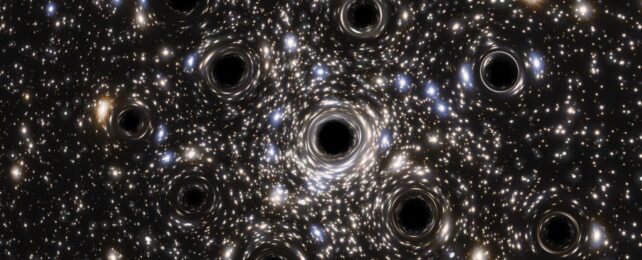The notion of black holes is one that invokes terror and dread. They're inescapable! They devour everything! Nothing ever comes out!
The accuracy of these beliefs falls on the spectrum of debatable to incorrect. And a pair of physicists has now calculated how proverbial blood might be wrung from the black hole stone. According to Zhan-Feng Mai and Run-Qiu Yang of Tianjin University in China, teeny tiny black holes could theoretically be used as a source of power.
Their calculations find that these ultradense objects could work as rechargeable batteries and nuclear reactors, providing energy on the scale of gigaelectronvolts.
Actually, the energy extracted doesn't come from within the black hole, but just outside it: the strongest known concentrations of gravity in the Universe.
Our Universe is thought to be riddled with black holes, but they're not always exactly easy to spot. What we have found suggests that these mysterious objects range in mass from about five times the mass of the Sun to tens of billions of solar masses.
But there's another black hole weight class – theoretically, at least. These are the primordial black holes, and they can be spatially tiny, down to subatomic sizes.
Where stellar mass black holes form from the collapsed cores of massive dead stars, primordial black holes are thought to have formed from overdensities in the primordial plasma that filled the Universe following the Big Bang.
We don't know if primordial black holes exist or not, but if they do, they open up a lot of possibilities. One is dark matter, for which primordial black holes have been considered an attractive candidate.
Now it seems we might be able to harness these hypothetical dimples in space-time in some way.
A battery converts non-electrical energy into electrical energy. A nuclear reactor harnesses the power of nuclear reactions to produce energy. And a tiny black hole, Mai and Yang argue, could theoretically do both.
"Taking the fact that the black hole has extremely strong gravitational force, an interesting question arises: considering at least theoretically, could we use the gravitational force of black holes to generate electric energy, i.e. make use of black holes as batteries?," they write in their paper.
"In this paper, we argue theoretically that we can use a Schwarzschild black hole as a rechargeable battery."
Now, there's a problem with very small black holes: Hawking radiation. This is mass lost by a black hole due to the interaction between the black hole's event horizon and the quantum fields in its vicinity. The smaller the black hole, the faster mass is lost via Hawking radiation. If a black hole is small enough, it will completely evaporate relatively quickly.
A small black hole is also expected to swallow matter very quickly, which would make it difficult to extract anything from the space around it.
Mai and Yang worked out that they could replenish and recharge a primordial black hole above a certain mass in such a way that it would produce electrical energy. An atom-sized black hole with a mass between 1015 and 1018 kilograms should be able to produce this energy when replenished with charged particles.
At maximum, the researchers calculated, the black hole can convert 25 percent of the input mass to energy. That's a 25 percent efficiency rate. Most commercially available solar panels have an efficiency rate below 23 percent.
The team also determined that a black hole could obtain a similar efficiency as a nuclear reactor. Their equations showed that, in the vicinity of a primordial black hole, 25 percent of the mass of an alpha particle, produced by radioactive decay, can be converted to kinetic energy.
It's not really something we're going to be able to test. Even if we knew for sure they were out there, we couldn't just go grab a primordial black hole, never mind contain and control it. But the analysis opens up some interesting food for thought.
In particular, the team says that their black hole reactor model falls just inside the mass range proposed for dark matter – raising the intriguing possibility that we could, perhaps, harness one of the most mysterious forms of matter in the Universe to power our fridges.
The research is due to be published in Physical Review D, and is available on arXiv.
